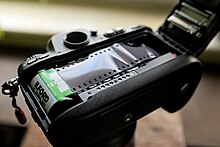| This article includes a list of general references, but it lacks sufficient corresponding inline citations. Please help to improve this article by introducing more precise citations. (November 2009) (Learn how and when to remove this message) |

Analog photography, also known as film photography, is a term usually applied to photography that uses chemical processes to capture an image, typically on paper, film or a hard plate. These processes were the only methods available to photographers for more than a century prior to the invention of digital photography, which uses electronic sensors to record images to digital media. Analog electronic photography was sometimes used in the late 20th century but soon died out.
Photographic films utilize silver halide crystals suspended in emulsion, which when exposed to light record a latent image, which is then processed making it visible and insensitive to light.
Despite a steep decline in popularity since the advent of digital photography, film photography has seen a limited resurgence due to social media and the ubiquity of digital cameras. With the renewed interest in traditional photography, new organizations (Film Is Not Dead, Lomography) were established and new lines of products helped to perpetuate analog photography. In 2017 B&H Photo & Video stated that film sales were increasing by 5% each year in the recent past.
Decline and revival

As digital photography took over, Kodak, the major photographic film and cameras producer, announced in 2004 that it would stop selling and manufacturing traditional film cameras in North America and Europe. In 2006, Nikon, the Japanese Camera maker announced that it would stop making most of its film cameras. Incurring losses in the film camera line, Konica-Minolta too announced its discontinuation of cameras and film. In 2008 the first instant film maker Polaroid announced it would stop making instant film.
Interest in all types of film photography has been in the process of revival. The Lomography movement started in 1992, which, BBC claimed, has saved film from disappearing. Lomography started manufacturing updated versions of toy cameras like Lomo LC-A (as Lomo LC-A+), Diana (as Diana F+), Holga, Smena and Lubitel.
Film photographers started experimenting with old alternative photographic processes such as cyanotypes, double exposures, pinholes, and redscales. Worldwide Pinhole Photography Day is observed on the last Sunday of April, every year. Organizations such as Roll4Roll spread the artistic movement of double exposures.
Film Photography Project, a website dedicated to film photography, announced in 2017 the comeback of large-format camera by a new startup called The Intrepid Camera Co.
Popularity

For those who are keen to work with, or do work with more traditional types of photography, dedicated online communities have been established in which like-minded individuals together share and explore old photographic practices. Film photography has become much more popular with younger generations who have become increasingly interested in the traditional photographic practice; sales in film-based cameras began to soar, and youth were seen to embrace some 19th-century technology. Young photographers say film has more 'soul' than digital. Camera manufacturers have also noticed the renewed interest for film, and new simple point-and-shoot film cameras for beginners, have started to appear.
Polaroid was once a power in analog instant photography. Facing the digital revolution, Polaroid stopped production of instant film in 2008. A new company called Impossible Project (now Polaroid through brand acquisition) acquired Polaroid's production machines to produce new instant films for vintage Polaroid cameras and to revive Polaroid film technologies.
Art forms

The revival of analog photography has resulted in new art forms and photo challenges, as the technical limitations and constraints of film are used as parameters of the art. In the 36 (or sometimes 24) frames challenges, a single roll of film must capture a specific event, time period or as exercises to improve photography skills.
In contact sheet photography, the traditional contact sheet is used as a way to make pictures consisting of partial photos. The resulting image spans the whole sheet, divided into squares by the black borders of the film.
Advantages and disadvantages
Main article: Comparison of digital and film photographyAdvantages
- The time and expense of film photography instills craft and patience; pre-film even more so.
- Vintage film cameras offer a tactile, hands-on experience that feels more deliberate and engaging.
- Each film stock delivers a distinct and consistent aesthetic that is difficult to achieve in digital photography.
- Depending on the film sensitivity one can obtain a wide dynamic range.
- A film-printed (non-editable) image can help as legal evidence of the subject pictured.
- In optimal processing and storage conditions, a film can have a lifetime duration.
Disadvantages
- Film photography requires photographers to invest more time and skill than digital.
- Film is delicate and requires careful handling, refrigeration, protection from the sun, protection from dust, etc.
- Film negatives and slides require proper developing, or they may suffer from deterioration such as fogging.
- Processing film is expensive and requires additional investment such as scanning, enlarging, or printing.
Material

Film photography does not just mean photographic film and its processing with photo chemicals. Itself a science and a craft of its own, changes in chemistry and developing time will affect the end result. An example is tintype photography. A tintype, also called ferrotype, is a positive photograph produced by applying a collodion-nitrocellulose solution to a thin, black-enameled metal plate immediately before exposure. The tintype, introduced in the mid-19th century, was essentially a variation on the ambrotype, which was a unique image made on glass instead of metal. Just as the ambrotype was a negative whose silver images appeared grayish white and whose dark backing made the clear areas of shadows appear dark, so the tintype, actually negative in its chemical formation, was made to appear positive by the black plate. These methods were not abandoned when film came to dominate photography.
Instant film develops an image automatically, and soon after it is ejected from the camera without any processing by the photographer or by a photographic lab. Photographic paper, however, must be processed after exposure in a dark room or photographic lab.
Processes
Main article: List of photographic processesBlack-and-white negative film may be processed using a variety of different solutions as well as processing time control, depending on the film type, targeted contrast, or grain structure. While many B&W processing developers are no longer made commercially, (Dektol, D-76 and T-Max developers are still made) other solutions may be mixed using original formulas. Color negative film uses C-41 process, while color reversible film uses E-6 process for color slides. Kodachrome used to have its own process with one developer bath per each film color layer.
Meanwhile, alternative photographers experiment with different processes such as cross processing which yields unnatural colors and high contrasts. This basically means processing a reversal film using a negative developer bath, or the contrary.
For a more sustainable photography, black and white negative film may be processed in plant-based chemicals at home.
Film processing does not use digital technology, since information is not translated into electric pulses of varying amplitude or binary data.
Format
Main article: Photographic filmPhotographic film


- Types
Films can be any of the following types:
- Daylight, in both negative and reversal color films
- Tungsten, in both negative and reversal color films
- Infrared, mostly for black and white films
Silver-based film supports come in various formats, of which the following are still in use:
- 110 film (mono-perforated roll in plastic cassette)
- 135 film 35 mm (bi-perforated roll in metal can)
- 120 film 60 mm (non-perforated roll in paper sleeve)
- Large format 4x5" 5x8" 8x10" etc. (gelatin sheets).
- Super-8 (mono-perforated roll in plastic cassette)
- Cinema 16 mm / 35 mm (bi-perforated roll on metal spool)
Black-and-white films still produced as of 2013 include:
- ADOX CHS 100 II
- ADOX CMS 20
- ADOX Silvermax
- ADOX HR-50
- CineStill BwXX
- Film Washi "W" 25
- FOMA FOMAPAN 100 Classic
- FOMA FOMAPAN 200 Creative
- FOMA FOMAPAN 400 Action
- FOMA FOMAPAN R 100
- FOMA RETROPAN 320 soft
- FujiFilm Neopan Acros 100
- Ilford Pan F Plus 50
- Ilford HP5 Plus 400
- Ilford FP4 Plus 125
- Ilford Delta 100
- Ilford Delta 400
- Ilford Delta 3200
- Ilford XP2 Super
- Ilford SFX 200
- JCH Street Pan 400
- Kentmere 100
- Kentmere 400
- Kodak T-MAX 100
- Kodak TMY-2 400
- Kodak TRI-X 400
- ORWO UN 54
- ORWO N 74 plus
- Rollei also markets a line of black-and-white films
Color films (mostly 135 and 120 formats) sold on the market in 2020 are:
- Fujichrome Velvia 50
- Fujichrome Provia 100F
- Kodak Ektachrome 100
- Kodak Ektar 100 Professional
- Kodak Portra 160 Professional
- Kodak Color Plus 200
- Kodacolor Gold 200
- Kodak Vision-3 250 Daylight
- Kodak Ultramax 400
- Kodak Portra 400 Professional
- Kodak Vision-3 500 Tungsten
- Cinestill Daylight 50
- Cinestill Daylight 400
- Cinestill Tungsten 800
- Hillvale Sunny 400
- Yashica Color 400
- Yashica Golden 400
See also
References
- "The photographers who refuse to abandon traditional film cameras". BBC News. 2015-04-18. Retrieved 2020-10-05.
- "The Great Film Renaissance Of 2017". B&H Explora. Retrieved 2020-10-05.
- "Kodak embraces digital revolution". 2004-01-13. Retrieved 2020-10-05.
- Davies, Catriona (2004-01-14). "Kodak to stop making 35 mm cameras". The Guardian. ISSN 0261-3077. Retrieved 2020-10-05.
- Associated Press (2006-01-13). "Nikon to stop making most film cameras". NBC News. Retrieved 2020-10-05.
- "Konica Minolta to stop making cameras and film amid big losses". the Guardian. 2006-01-20. Retrieved 2020-10-05.
- "Fans bid farewell to Polaroid film – CNN.com". edition.cnn.com. Retrieved 2020-10-05.
- Dowling, Stephen (2012-11-22). "Did the Lomo camera save film photography?". BBC News. Retrieved 2020-10-05.
- "Worldwide Pinhole Photography Day". pinholeday.org. Retrieved 2020-10-05.
- "A roll for a roll". roll4roll. Retrieved 2020-10-05.
- "Intrepid 8x10 Camera – Affordable (NEW!) Large Format Camera". The Film Photography Project. 2017-06-14. Retrieved 2020-10-05.
- "Archived copy". Archived from the original on 2006-10-02. Retrieved 2006-11-04.
{{cite web}}: CS1 maint: archived copy as title (link) - "Teen hipsters discover joys of film photography". cnet.com. 16 May 2011. Retrieved 9 April 2018.
- Stummer, Robin (28 January 2018). "Back to the darkroom: young fans reject digital to revive classic film camera". The Guardian. Retrieved 24 February 2021.
- Schneider, Jaron (24 February 2021). "Harman Technologies Announces Point-and-Shoot EZ-35 Film Camera". www.petapixel.com. PetaPixel. Retrieved 24 February 2021.
- "Film Photography: 36 Frames to Better Images". www.thephotographytoolkit.com. The Photography Toolkit. 23 October 2020. Retrieved 24 February 2021.
- Cade, DL (6 March 2020). "Photo Challenge: Shooting BMX on a Nikon F100 and a Single Roll of Kodak Tri-X". www.petapixel.com. Petapixel. Retrieved 24 February 2021.
- Barnes, Sara (20 April 2018). "Photographer Transforms Everyday Subjects Into Fractured Versions of Themselves". www.mymodernmet.com. My Modern Met. Retrieved 24 February 2021.
- Wortham, Jenna (2012-05-30). "Just When You Got Digital Technology, Film Is Back (Published 2012)". The New York Times. ISSN 0362-4331. Retrieved 2020-10-05.
- "Tintype | photography". Encyclopedia Britannica. Retrieved 2020-10-05.
- "FOMA – Films". FOMA. Archived from the original on 2013-04-12. Retrieved 2016-10-30.
- "ORWO FilmoTec – Camera Films". ORWO FilmoTec GmbH. Archived from the original on 2016-03-03. Retrieved 2016-10-30.
Further reading
- Glenn D. Considine, Van Nostrand's Scientific Encyclopedia, Two-Volume Set, 9th Edition (Hoboken, NJ: Wiley, 2002).
- Peter M.B. Walker, Chambers Technical Dictionary (Edinburgh: Chambers 1999).
- William J. Mitchell, The reconfigured eye: visual truth in the post-photographic era (MIT Press, 1994).